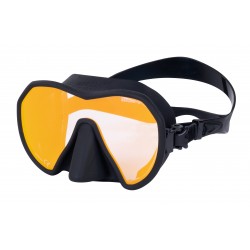Eco-friendly neoprene
At Beuchat, our products are intimately linked to the sea, a wonderful but fragile universe. The eco-responsible commitment to preserve and protect it is therefore obvious for Beuchat. This approach is materialized by actions implemented within the company and in particular in the manufacture of our products, using new production methods.
To understand the environmental impact of these new production methods, we must first remember that neoprene is initially made from petroleum. Its production emits a significant dose of CO2, especially during the extraction and processing phases of the raw material. In addition, petroleum is a non-renewable and non-biodegradable material. Moreover, it generates air pollution due to emissions of VOCs (Volatile organic compounds) caused by the use of solvents for the bonding steps.
Does it seem absurd to you to enjoy the sea wearing a suit which, by nature, is polluting it? We also find it nonsensical.
What have we changed for this?
That is why we have chosen to adopt a new type of eco-friendly neoprene, oil-free, which is now used in the manufacture of the majority of our diving, freediving and hunting suits, as well as in that of our neoprene accessories.
Let us tell you more about this technology!
Our new neoprene is made of limestone, which comes from the earth, and replaces the petrochemicals generally used in the manufacture of this material. It is therefore directly extracted from nature, and its impact on the environment is considerably reduced.
The second key component of neoprene is carbon black. Thanks to new production technologies in our factories, it is now pyrolyzed from pieces of caoutchouc tires. This manufacturing process significantly reduces energy consumption and therefore CO2 emissions. These are reduced by 24%, which equals 2.689 kilograms less, per wetsuit.
These two raw materials are transformed into neoprene using a formula that eliminates almost all traces of polycyclic aromatic hydrocarbons, and it becomes the caoutchouc foam we all know!
From neoprene to a wetsuit
Glue is used for the lamination of diving clothing and accessories, which is the bonding between the neoprene and the fabric that covers the neoprene foam.
Since January 2021, the glue that we use is water-based, and no longer solvent-based. This is also a big step forward in terms of respect for the environment. Through this process, up to 600 grams of harmful volatile organic compounds (VOCs) are removed from each suit.
We always want to take that dynamic further, that is why on our new Inspiro suit, and inside our Zento model, black threads that make up the fabric are produced by infusing pigments into a molten plastic solution. This new technique saves huge amounts of water compared to the traditional process, while reducingenergy consumption and water pollution. 104 liters of water resources are thus preserved per kilogram of neoprene produced, and for the same amount, carbon footprint is reduced by 26%.
In addition, the fabrics of the coveralls are knitted with polyester yarn made from recycled plastic bottles. This process reduces both water and material consumption. With 45 recycled plastic bottles, we can thus produce a wetsuit!
The sea is the field of expression of our passion, but it also plays a fundamental role in the balance of our ecosystems. All together, let's keep enjoying and protecting it a little more each day!



 Snorkeling
Snorkeling
 Beuchat Team
Beuchat Team
 Scuba diving
Scuba diving
 Free Diving
Free Diving
 Snorkeling
Snorkeling
 Beuchat Team Spearfishing
Beuchat Team Spearfishing







